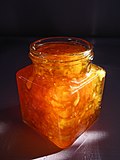Fruit preserves
Fruit preserves are preparations of fruits, sugar, and sometimes acid, often canned or sealed for long-term storage. The preparation of fruit preserves traditionally involves the use of pectin as a gelling agent, although sugar or honey is also used. The term "preserves" is usually interchangeable with "jams". Some cookbooks define preserves as cooked and gelled whole fruit (or vegetable), which includes a significant portion of the fruit.
Etymology[edit]
The term "preserve" comes from the Latin praeservare, which means to guard or to protect. The process of making preserves is a method of food preservation, which is why the term "preserve" is used.
Types of Fruit Preserves[edit]
There are several types of fruit preserves, including jam, jelly, marmalade, conserves, and fruit butter. Each type has its own unique characteristics and preparation methods.
Jam[edit]
Jam is a type of fruit preserve that is made from crushed or chopped fruits that are cooked with sugar. The fruit is cooked until it reaches a gel-like consistency.
Jelly[edit]
Jelly is a type of fruit preserve that is made from fruit juice that is cooked with sugar and pectin. The fruit juice is strained before it is cooked to remove any seeds or pulp.
Marmalade[edit]
Marmalade is a type of fruit preserve that is made from citrus fruits. The peel of the fruit is often included in the preserve, giving it a distinctive bitter taste.
Conserves[edit]
Conserves are a type of fruit preserve that is made from a mixture of fruits. They are often used as a spread for breads and pastries.
Fruit Butter[edit]
Fruit butter is a type of fruit preserve that is made from pureed fruit that is cooked with sugar. The fruit is cooked until it reaches a thick, creamy consistency.
Related Terms[edit]
- Canning: The process of preserving food by heating it and sealing it in airtight containers.
- Pectin: A naturally occurring substance in fruits that is used as a gelling agent in the preparation of fruit preserves.
- Preservation (food): The process of treating and handling food to stop or slow down food spoilage, loss of quality, edibility, or nutritional value.
Ad. Transform your life with W8MD's Budget GLP-1 injections from $75


W8MD offers a medical weight loss program to lose weight in Philadelphia. Our physician-supervised medical weight loss provides:
- Weight loss injections in NYC (generic and brand names):
- Zepbound / Mounjaro, Wegovy / Ozempic, Saxenda
- Most insurances accepted or discounted self-pay rates. We will obtain insurance prior authorizations if needed.
- Generic GLP1 weight loss injections from $75 for the starting dose.
- Also offer prescription weight loss medications including Phentermine, Qsymia, Diethylpropion, Contrave etc.
NYC weight loss doctor appointmentsNYC weight loss doctor appointments
Start your NYC weight loss journey today at our NYC medical weight loss and Philadelphia medical weight loss clinics.
- Call 718-946-5500 to lose weight in NYC or for medical weight loss in Philadelphia 215-676-2334.
- Tags:NYC medical weight loss, Philadelphia lose weight Zepbound NYC, Budget GLP1 weight loss injections, Wegovy Philadelphia, Wegovy NYC, Philadelphia medical weight loss, Brookly weight loss and Wegovy NYC
|
WikiMD's Wellness Encyclopedia |
| Let Food Be Thy Medicine Medicine Thy Food - Hippocrates |
Medical Disclaimer: WikiMD is not a substitute for professional medical advice. The information on WikiMD is provided as an information resource only, may be incorrect, outdated or misleading, and is not to be used or relied on for any diagnostic or treatment purposes. Please consult your health care provider before making any healthcare decisions or for guidance about a specific medical condition. WikiMD expressly disclaims responsibility, and shall have no liability, for any damages, loss, injury, or liability whatsoever suffered as a result of your reliance on the information contained in this site. By visiting this site you agree to the foregoing terms and conditions, which may from time to time be changed or supplemented by WikiMD. If you do not agree to the foregoing terms and conditions, you should not enter or use this site. See full disclaimer.
Credits:Most images are courtesy of Wikimedia commons, and templates, categories Wikipedia, licensed under CC BY SA or similar.
Translate this page: - East Asian
中文,
日本,
한국어,
South Asian
हिन्दी,
தமிழ்,
తెలుగు,
Urdu,
ಕನ್ನಡ,
Southeast Asian
Indonesian,
Vietnamese,
Thai,
မြန်မာဘာသာ,
বাংলা
European
español,
Deutsch,
français,
Greek,
português do Brasil,
polski,
română,
русский,
Nederlands,
norsk,
svenska,
suomi,
Italian
Middle Eastern & African
عربى,
Turkish,
Persian,
Hebrew,
Afrikaans,
isiZulu,
Kiswahili,
Other
Bulgarian,
Hungarian,
Czech,
Swedish,
മലയാളം,
मराठी,
ਪੰਜਾਬੀ,
ગુજરાતી,
Portuguese,
Ukrainian










